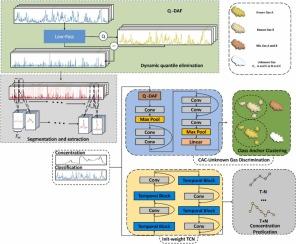Gas classification and concentration prediction in open environments using class anchor clustering-initialized temporal convolutional network
IF 8
1区 化学
Q1 CHEMISTRY, ANALYTICAL
引用次数: 0
Abstract
Identifying target gases and predicting their concentrations in open environments are critical tasks, particularly due to fluctuating environmental conditions and the presence of unknown gases. This study aims to address these challenges by developing a model that improves both gas classification and concentration prediction. We introduce two key components: Quantile-Dynamic Associated Features (Q-DAF) and the Class Anchor Clustering-Initialized Temporal Convolutional Network (CAC-InitTCN). Q-DAF dynamically enhances gas signal feature extraction, optimizing the ability of CAC-InitTCN to handle complex and changing gas environments. CAC-InitTCN is designed to efficiently process time-series data, allowing it to manage gas concentration fluctuations while mitigating the interference of unknown gases. CAC-InitTCN was evaluated on two distinct datasets, achieving classification accuracy rates of 93.62 % and 98.05 %, respectively. In gas concentration prediction tasks, the model demonstrated RMSE values of 0.2102 and 0.0392, and R2 scores of 0.9085 and 0.9784, after data normalization. These results demonstrate the capability of CAC-InitTCN in handling real-time gas fluctuations and recognizing unknown gases, making it a promising approach for open-environment gas detection.

使用类锚聚类初始化时空卷积网络进行开放环境中的气体分类和浓度预测
识别目标气体并预测其在开放环境中的浓度是一项至关重要的任务,特别是由于环境条件的波动和未知气体的存在。本研究旨在通过开发一种能同时改进气体分类和浓度预测的模型来应对这些挑战。我们引入了两个关键组件:量子动态关联特征(Q-DAF)和类锚聚类初始化时空卷积网络(CAC-InitTCN)。Q-DAF 动态增强了气体信号特征提取,优化了 CAC-InitTCN 处理复杂多变气体环境的能力。CAC-InitTCN 设计用于高效处理时间序列数据,使其能够管理气体浓度波动,同时减轻未知气体的干扰。CAC-InitTCN 在两个不同的数据集上进行了评估,分类准确率分别达到 93.62% 和 98.05%。在气体浓度预测任务中,模型的 RMSE 值分别为 0.2102 和 0.0392,数据归一化后的 R2 分数分别为 0.9085 和 0.9784。这些结果证明了 CAC-InitTCN 在处理实时气体波动和识别未知气体方面的能力,使其成为一种很有前途的开放环境气体检测方法。
本文章由计算机程序翻译,如有差异,请以英文原文为准。
求助全文
约1分钟内获得全文
求助全文
来源期刊

Sensors and Actuators B: Chemical
工程技术-电化学
CiteScore
14.60
自引率
11.90%
发文量
1776
审稿时长
3.2 months
期刊介绍:
Sensors & Actuators, B: Chemical is an international journal focused on the research and development of chemical transducers. It covers chemical sensors and biosensors, chemical actuators, and analytical microsystems. The journal is interdisciplinary, aiming to publish original works showcasing substantial advancements beyond the current state of the art in these fields, with practical applicability to solving meaningful analytical problems. Review articles are accepted by invitation from an Editor of the journal.
 求助内容:
求助内容: 应助结果提醒方式:
应助结果提醒方式:


